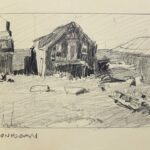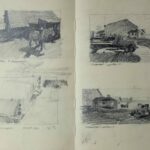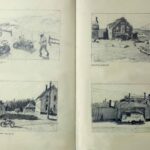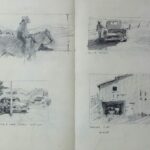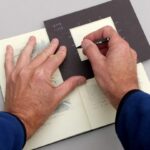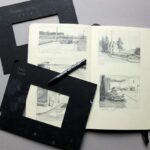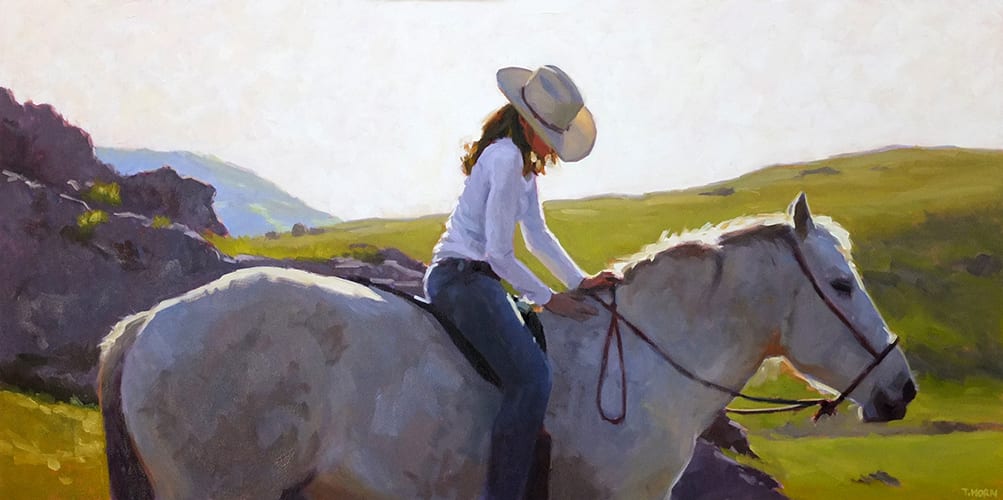 Ever since beginning college level art courses, I’ve been advised by my instructors to always carry a sketch book. I was a graphic design major, but was always taking drawing, sculpture, photography and countless other fine art courses. I’ve tried many times to get in the habit, but it never stuck. When I started painting 15 years ago, I felt the need for a sketch book to try and work out compositions of a scene before I started in on the painting. This time it stuck! I’ve since filled eight sketch books and this has become an essential and enjoyable part of my process in creating a painting.
Ever since beginning college level art courses, I’ve been advised by my instructors to always carry a sketch book. I was a graphic design major, but was always taking drawing, sculpture, photography and countless other fine art courses. I’ve tried many times to get in the habit, but it never stuck. When I started painting 15 years ago, I felt the need for a sketch book to try and work out compositions of a scene before I started in on the painting. This time it stuck! I’ve since filled eight sketch books and this has become an essential and enjoyable part of my process in creating a painting.
The sketch book I use is a Moleskine 5 x 8 1/4” with heavy weight paper. (Look for the periwinkle label, 104 pages) I like this one better than all the others I’ve tried. It opens flat without a spiral binding getting in the way, the size is perfect and the paper is a nice, durable weight. Very well made with a sturdy binding. I use a Cretacolor Monolith 4B graphite stick, the soft lead allowing for rich darks and loose, soft marks. And a Leuchtturm 1917 “pen loop” keeps my pencil close at hand.
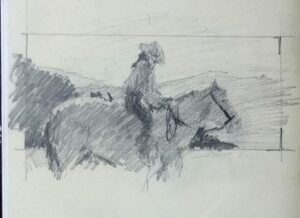 My sketching routine includes the use of viewfinders which I make out of black illustration board. I have a different viewfinder for every proportion canvas I paint on. I walk around a location looking through my viewfinder until I see a combination of value shapes that looks promising. I then put my viewfinder against a page in my sketchbook, and use the window to draw a box on the page with my pencil. If I’m going to paint on an 8×10” panel, I’ll use a viewfinder with an 8×10” proportion window, thus matching that same proportion in my pencil sketch. It’s important for me to control my composition and I find this strategy very helpful.
My sketching routine includes the use of viewfinders which I make out of black illustration board. I have a different viewfinder for every proportion canvas I paint on. I walk around a location looking through my viewfinder until I see a combination of value shapes that looks promising. I then put my viewfinder against a page in my sketchbook, and use the window to draw a box on the page with my pencil. If I’m going to paint on an 8×10” panel, I’ll use a viewfinder with an 8×10” proportion window, thus matching that same proportion in my pencil sketch. It’s important for me to control my composition and I find this strategy very helpful.
When I’m preparing to do a plein air painting, I’m always eager to get started and therefore do a loose, quick sketch for not more than 5 minutes. In the studio, working from photo references, I make a more careful drawing, spending 10 – 12 minutes. A nice pencil drawing is not my goal, so I’m careful to not get too caught up in the drawing, saving my creative, observational, right brain energy for the painting itself.
In the drawing, I’m working out compositional issues as well as trying to see a value pattern. I’m not trying to limit the number of values I work with, because graphite will give you a huge range. My effort is more geared toward establishing the light in a scene, by separating light areas from shadow areas. It also really helps to get me warmed up and engaged with the scene in front of me. No matter how long I stare at something, I don’t really see it ALL until I begin the process of recording my observations.
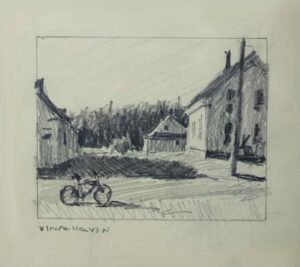 Every now and then I get a drawing that really captures the light and I’m always amazed that this can be achieved in just a quick pencil sketch. I sometimes do more than one sketch for a scene – experimenting with different compositions – but most of the time it’s just one sketch and then on to the painting. If the sketch turns out nicely, then I’m encouraged and excited to move ahead with painting, and might refer to it briefly trying to keep what it was about the sketch that appealed to me.
Every now and then I get a drawing that really captures the light and I’m always amazed that this can be achieved in just a quick pencil sketch. I sometimes do more than one sketch for a scene – experimenting with different compositions – but most of the time it’s just one sketch and then on to the painting. If the sketch turns out nicely, then I’m encouraged and excited to move ahead with painting, and might refer to it briefly trying to keep what it was about the sketch that appealed to me.
Over 15 years, I’ve filled eight sketchbooks and can say with absolute confidence that my drawing and observational skills have improved. I never draw just to draw, it is always a step in the process toward a painting. I don’t consciously work on improving my drawing, it’s just a natural byproduct of constantly being in the mode of translating what’s in front of me into marks on a two dimensional plane. Also, the great thing about doing a drawing first is that it’s ALL you’re doing. That’s it. Once you move on to the painting, numerous other issues and challenges come up such as color, value, brushwork, etc. so it’s very helpful to do this first step and simply DRAW without the other distractions.
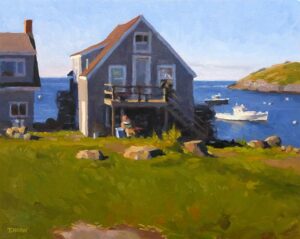 The sketchbooks now serve as a chronicle of my life since I started painting. They place paintings in a time specific context and include street names, painting locations, names of people I met while painting, times of day and other random bits of information. They are a great reference to have and a diary of all my painting adventures over the years. I’ve thought about doing larger, more finished drawings. But for now, the sketches in the book are enough.
The sketchbooks now serve as a chronicle of my life since I started painting. They place paintings in a time specific context and include street names, painting locations, names of people I met while painting, times of day and other random bits of information. They are a great reference to have and a diary of all my painting adventures over the years. I’ve thought about doing larger, more finished drawings. But for now, the sketches in the book are enough.
Oil Painting
OPA 2015 Western Exhibition Winner Spotlight
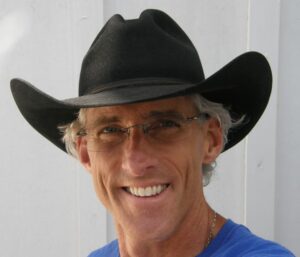
Johne is a native of Kansas, with a love of the prairie, and other wide-open spaces. He has painted for more than thirty-five years, most of that in watercolor. He fell into oil painting comparatively recently, and when he got himself cleaned up (which he discovered was quite a bit more of a job than with watercolor) he realized it was a medium he could be content with, and for quite some time.
Johne lives in Overland Park with his wife Janet. They have three mostly grown children, and any number of cats and dogs.
“As an artist, I have a great passion for the outdoors, and a great affection for cowboys, and the western landscape. I look for interesting stories, and compelling visual drama, and try to speak to what moves me, emotionally, on the surface of my paintings. I don’t feel the need, creatively, to add intellectual content in creating a dialog with the viewer- the subject inherently having interest, and substance, all on its own.
My figures tend to be presented large, and up close, to create an inescapable intimacy, and expression of character, or at a distance, to reflect the human scale within the enormity of the wide-open landscape. Occasionally a steer wanders by, and I’ll become entranced with the play of light on horns, or a fierce posture, or expression. And the elusive, curving brim of a cowboy hat, as it moves and changes in the light, is perhaps the most captivating and challenging subject I’ve ever encountered.
I get emotionally involved with my subject, whether it’s a figure, or a landscape. When I paint, I try to tell the story of what moved me, and with the same energy and passion with which I absorbed the image initially. It could be the gesture, the color, the surface patina, the light… but mostly, it’s the light.”
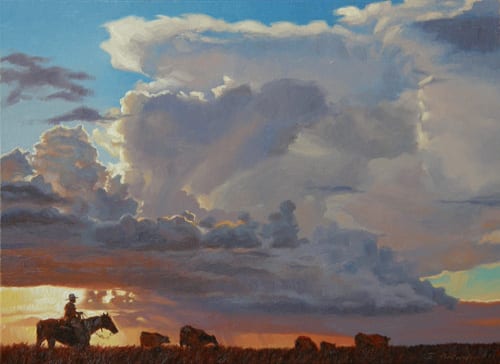
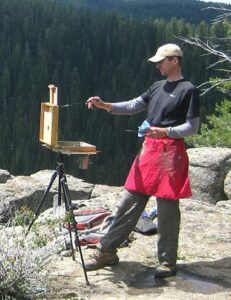
Born in 1977, David Dibble was raised on a farm in Davis County, Utah, where he was influenced by the landscape from an early age. He created art all through his youth, and completed a BFA in Illustration from Brigham Young University.
David began landscape painting in earnest in graduate school at the Academy of Art University, and following the Academy he and his wife Liz moved to New York, where he worked as a color artist for Blue Sky Studios (20th Century Fox), creating Concept Design for such films as Rio, Epic, Ice Age 4, and Peanuts. David and his family now reside in Orem, Utah, where David teaches Illustration at Brigham Young University and paints often in the surrounding mountains and valleys.
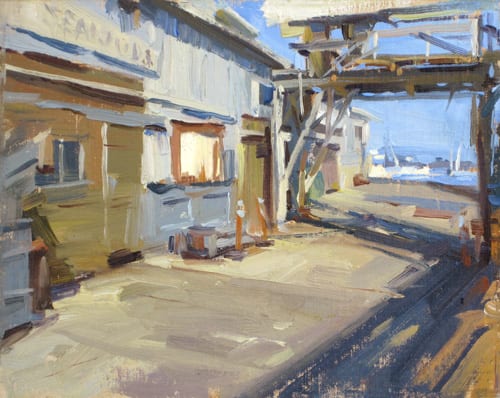
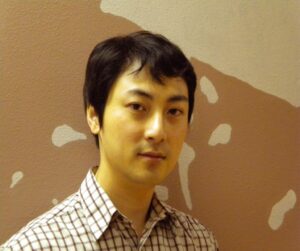
In 1974 Shanghai I was born into one of the biggest urban centers in China. A well noted artist in the local area introduced me to drawing at the young age of 11 and allowed me to take my first step onto the long road of the study of art. Upon graduation from the University of Shanghai with a major in Fine Arts, I painted voraciously without rest. I then met the man who would become my instructor, Xiaofu Yu, a true master in oil painting. Nearly all of my present painting skill derived from my apprenticeship under him.
In searching for ever more difficult challenges and a bigger stage to present my works I immigrated to America in 1998.Free-spirited Americans living in such a diverse and energetic society became a great inspiration. This soon led me to create the most prolific outpouring of all of my works. Vivid reflections of my newest experiences in this land and the raw emotions connected with them were shown on canvas with each paint stroke. I couldn’t help but have my emotions evoked every single day by the beauty of color and life that lay around me. I came to live in Southern California where I was lucky enough to have met my wonderful wife and had our son. I currently own an art school in the city of Walnut where I enjoy my time teaching students and continue my painting.
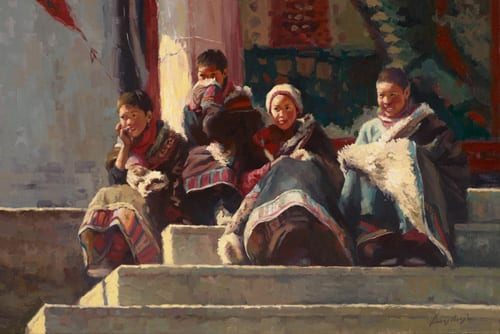
Summer 2015 Online Showcase Award Winners
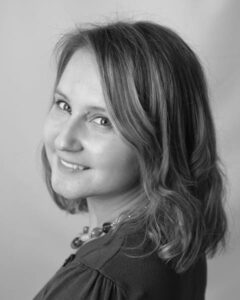
Marci Oleszkiewicz, grew up in the city of Chicago in a family of four. Her mother home schooled all four children where each child’s gifts were nurtured and encouraged. Marci’s father was a carpenter and there wasn’t a moment in childhood that he was not renovating or working on some project for their home. Looking back Marci attributes much of her creativity to seeing her father always working on something, creating something out of nothing. “My dad would say see Marci if you work at something little by little you will see your idea come about. Seeing my Dad’s work ethic and learning from my Mom the value of self discipline as a home schooler, I believe gave me some of the foundational tools I would need later in life to succeed as an artist.”
Marci’s passion for art was inspired at a young age. As a child, she remembers sitting at her little desk making pictures.
“It seemed I often communicated visually.Whether it was in a Christmas card to family or a personal journal entry, there was always a drawing to be found. I remember imagining my little creations coming alive as I made the final touches.”
A statement from the Juror of Awards, Kathy Anderson:
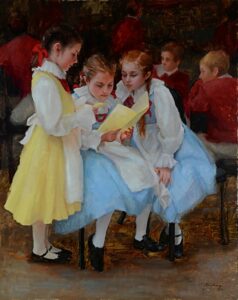
My choice for 1st place in this competition was very easy and instantly identifiable. It fit my criteria of telling an interesting story, or handling a subject in an original way. I’m very drawn to beautiful clean color, and skill in drawing. The little girls in their pastel dresses were a perfect match for me!”
Although she has been studying art and painting for some time, it wasn’t until 2007 when things started to move forward and she began to see what the future might hold for her as an artist. Upon entering several art competitions Marci was not only accepted in two of the top shows, The Oil Painters of America’s national show and the American Impressionist Society’s national show, but also received very substantial awards from both. An award of excellence from the OPA and the best of show award from the AIS. Not long after, she was included in Southwest Art Magazine’s 21 under 31 and had her first two man show at Gallery Russia in Scottsdale, AZ. “Receiving so many incredible honors, one after another, really encouraged and pushed me into becoming a full time painter.” Since then Marci has continued to paint full time, focusing on her annual show that comes up every March at Gallery Russia in Scottsdale, AZ. “I am always so encouraged to hear the response from my collectors every year, how they connect and are so touched by what I paint. It is my goal as an artist to do just that, to create works that resonate with the hearts of others, to speak clearly and deeply to the innermost being. To capture moments of life on canvas that convey beauty, joy, love and truth. I’ve heard it said if you paint from your heart you will speak to the hearts of your viewers, and that is my desire.”
“The Lord has blessed me with this passion for art and I am delighted to be able to share what I see with my students and collectors to show them the beauty and love that surrounds them.”
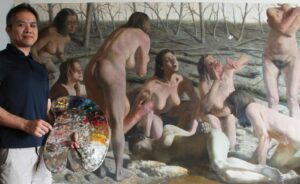
Zimou Tan was named “Chinese Master Artist” in December of 2007 by the Chinese government Art and Culture department, also selected as “The 50 Artists impacted China”. Tan was born and raised in Canton, China, apprenticed to Chinese Master Artist Le, YiFeng at age 12. At age 14 he immigrated to America with his family. Tan taught at art university for about 13 years after his graduation.
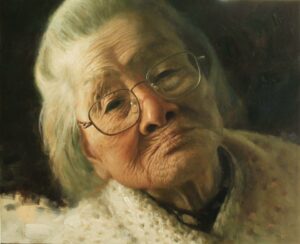
Tan has been running Tan’s fine art studios onsite and online, you can find Tan’s demo videos on Youtube, and Vimeo. Tan is specialized in fine art portraitures, to capture the spirit of his subjects. Since 2001, Tan had won numerous painting awards, and published in magazines. Tan is currently the director of Olivet College of Art and Design.
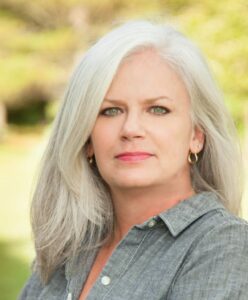
Recognized for her expressive brushwork, intelligent composition, and superb use of color, Nashville Tennessee native, Lori Putnam paints small to medium-sized works en plein airand creates large paintings in her studio. She travels extensively to paint, teach, and share her work around the world.
Prior to becoming a full-time, fine artist in 2005, Putnam owned and managed a graphic design agency for 13 years. In 2008 and 2009, she and her husband sold all of their belongings and traveled to the Italian countryside to live for more than seven months with the sole purpose of the painter’s self-study and artistic growth. A catalyst for Putnam’s artistic career, the concentrated work accomplished during that period culminated in an impressive breakthrough. Advice from artist friends Scott Christensen, Quang Ho, and Dawn Whitelaw, has further impacted the artist’s development and success.
Featured in numerous issues of American Art Collector Magazine, Plein Air Magazine, Southwest Art, Fine Art Connoisseur, and Art of the West, Putnam is recognized as one of the finest American Impressionists of our time. As an Artist Faculty Demonstrator for the Annual Plein Air Convention, she shares her philosophy and painting methods with its 700 attendees annually.
Lori is a member of, and has exhibited with many respected organizations including the Salmagundi Club in New York City, the Oil Painters of America, Laguna Plein air Painters Association, the California Art Club, Plein Air Artists of Colorado, and is past Vice President of the American Impressionists Society. Additionally, Lori participates annually in several invitational plein air events, and winning awards in Colorado, California, Wyoming, Florida, Georgia, and Ireland. Her studio work has also received many awards — most notably from the Salmagundi Club in New York City, the Portrait Society of America, The American Impressionist’s Society, and the Oil Painters of America. Putnam’s art is in the permanent collection at The Academy Art Museum in Easton, Maryland, the Jack Warner Collection, the collection of Plein Air Magazine, and in private and corporate collections, and galleries worldwide. She keeps a studio in Charlotte, Tennessee.
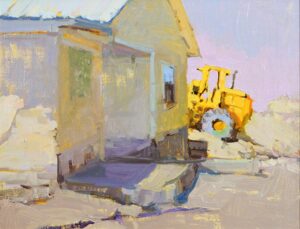
“As a Contemporary American Impressionist, I capture the character of a person, the uniqueness of a place, the color of time, and the relationship of things. Rather than merely copying, I use paint to interpret and to express. What interests me is rarely any specific subject unto itself. Color harmonies, rhythms, patterns, shapes, and my response to these elements excite me. Seeing the world in this way gives me the freedom to explore any subject. The end result, the art itself, engages its viewers inviting them to find their own, personal interpretations.”
Virtuosos of the OPA Exhibition at New York's Salmagundi Club

David A Leffel is a modern master recognized by his peers as a painters’ painter. His subjects range from figure and portrait to landscape and still life but his real subject matter is light flowing and drifting over surfaces.
He grew up in New York City and studied art and painting at Parsons School of Design, Fordham University and then at the Art Students League of New York. He later returned to the ASL as an instructor until he moved to Taos, NM in 1992.
Leffel has received many honors in his career including Gold and Silver medals at NAWA now called the Prix de West; Allied Artists, NY; and National Academy of Design, NY. He has also participated in many group and one-person shows.
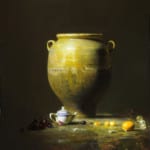
In 2003 a collection of his teachings, An Artist Teaches, Reflections on the Art of Painting was published by Bright Light Publishing to world-wide acclaim for its ability to integrate his philosophical views and humor with an understanding of technique that can be appreciated by artists and collectors alike. In 2009 Bright Light also published his second book, Self-Portraits: A Visual Journey of Insight.
His work can be found in permanent Museum collections throughout this country as well as numerous private collections here and abroad.
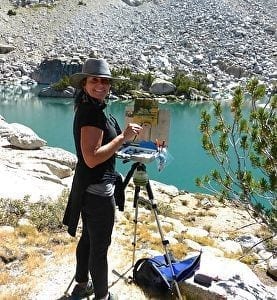
Like all artists, I feel like I was born to create and was drawn to art from as early as I can remember. After earning my degree in architecture from the University of Washington, I combined my professional life with my love of travel, working in locations throughout the world. My extensive travels and life experiences provide the solid platform from which my artwork is created.
My work is created primarily in oils, but I also enjoy working in acrylics and pastels in my representational style. My early training established a strong foundation in the Russian Impressionist tradition of seeing and painting shapes of light and color using relatively loose brushstrokes. I have studied extensively and been influenced by numerous historic artists, most notably Nicholai Fechin, John Singer Sargent and William Merritt Chase. All of these influences have allowed me to establish my own unique artistic style and define me as a truly versatile artist. While I am drawn to many painting genres; still life, landscape, cityscapes and figurative, my individual style and paint application is a constant theme throughout my work, creating a consistent body of art that is uniquely my own. Collectors continuously say they “can spot my work from across the room”. Establishing my own, unique, artistic voice is my primary goal and collectors appreciate the fact that I will never paint the same image twice, every piece that I create is truly an original, completed to my highest standards.

I am thankful to have the opportunity to pursue this passion I call art! Through my art I have had the opportunity to establish many long term friendships with collectors, galleries and other artists. When a collector purchases a piece I do not view it as a one time event, I view it as a new friend for life. I am extremely grateful for those who have supported me and hope you will continue to appreciate and support all artists who are making the world a more beautiful place.
Michele’s award-winning artwork has shown in both group and solo gallery exhibitions, in regional, national and international juried exhibitions, and has won numerous awards. Recently, Michele has followed her passion to teach, conducting ongoing workshops and art demonstrations. She has proven to be a popular juror. Her artwork can be found in public and private collections throughout the world.
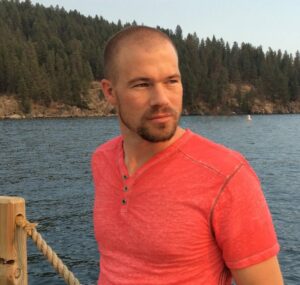
Born in 1979 Albin’s interest in art came at an early age. He is very grateful to his parents who were instrumental in promoting his emerging talent.
In 2006 Albin received his BFA from Brigham Young University Idaho. He credits the knowledgeable and student oriented faculty of the BYUI art department for giving him “the tools all representational artist must have to open the door to communicating in the visual arts”. Direction was also given to Albin which helped him break into the gallery scene while he was a college student. Since then Albin has continued in developing his career receiving honors from several prestigious organizations and shows.
Albin’s career has been a continual learning experience. His growth comes natural as he seeks for excellence through education and hard work. He is constantly finding new things to appreciate in the masters both living and deceased. Some of the influences he credits for his inspiration and development are Nicolai Fechin, John Singer Sargent, Abram Arkhipov, Joaquin Serolla, Ilha Repin, Richard Schmid, Dan Gerhartz, Mike Malm, Carolyn Anderson, Gerald Griffin and Leon Parson.
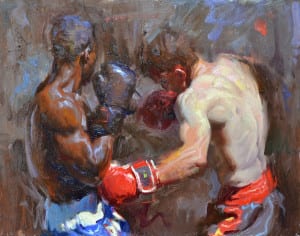
Albin Currently lives in Rexburg Idaho with his wife Jenee and their three children. He also teaches painting part time at BYU Idaho where his art education commenced. “Teaching is another way I can share the beauty of what I have learned and I find opportunities to improve my art through the constant re-evaluation that comes through teaching.”
“If I can enrich the lives of those who view my work in any way, I have accomplished my goal. There is something of the divine that comes through the work of one who has mastered his mode of expression and who has something good to say. Be it simple or profound, intellectual or spiritual, when that message comes through and awakens something within the receiver that improves
his or her life; that, I believe, is the higher purpose of art. That’s what I strive for.”
Dear Dad
Dear Dad,
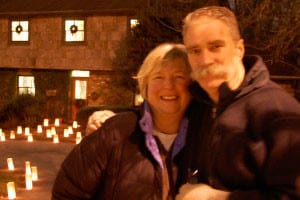 It has been over forty-five years since you passed away, and I have never written you. Not because I don’t know your address, it’s just that I have spent most of my life without you. While your absence has been real, life (you know, that thing that is both painful and rich and sometimes both) has carried on and I have been living it. You may never hear these words I write today, or maybe, just maybe, you know what these words mean even before I write them. Meanwhile, it’s probably good for me to do this… no therapist suggested it, I just wanted to.
It has been over forty-five years since you passed away, and I have never written you. Not because I don’t know your address, it’s just that I have spent most of my life without you. While your absence has been real, life (you know, that thing that is both painful and rich and sometimes both) has carried on and I have been living it. You may never hear these words I write today, or maybe, just maybe, you know what these words mean even before I write them. Meanwhile, it’s probably good for me to do this… no therapist suggested it, I just wanted to.
Of course, I could write a book! But the one thing I want to tell you about is my wife, Kathie. She hails from West Tennessee, but I have solidly converted her to the East Tennessee Mountains. You’d like her. She comes from a long line of hard-working, blue collar, hammer-throwing, dirt-loving people. Like you. She has raised three kids that would pop your buttons (one of them is named after you), wants to be outside as much as possible and is truly extraordinary with people. But over the past several years she has rediscovered a way of seeing things that, while she always had it, was covered up by the routines of living. She is an oil painter. A Plein Air oil painter.
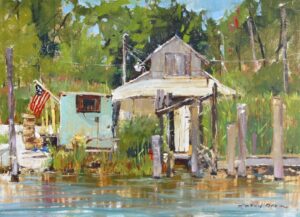 Which is to say: she has a backpack filled with easel, brushes and mineral spirits sitting at the back door waiting for her to load the car and head to the fields. Or mountains. Or waters. Or any place that grabs her.
Which is to say: she has a backpack filled with easel, brushes and mineral spirits sitting at the back door waiting for her to load the car and head to the fields. Or mountains. Or waters. Or any place that grabs her.
I am not sure exactly how to say this next part. But it’s the thing that makes me stand back and marvel at her. The great artists (I imagine) not only see the landscape, but also, somehow receive it. They don’t just reproduce what they see in a colorful way, they let the landscape enter them. And I think it is Kathie’s way of, may I say, contemplation. It’s a slowing down and a sort of participation with what is in front of her. She is not trying to make a statement or be productive with her work; she is receiving it and being received by it. When painting, it feels as though she is carrying on an unhindered dialogue.
About five times throughout the year she participates in a Plein Air competition. Yes, I know, it doesn’t sound like something that a Contemplative Artist would do, but hear me out. Over four or five days she hunts for a venue that speaks to her, carries on her dialogue with the landscape, and then moves to another. At weeks end a judge honors a few outstanding pieces from the 30-40 painters, while art enthusiasts seize the chance to make a purchase.

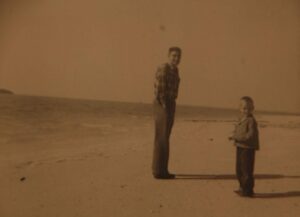
Receiving an award or selling a painting simply tells me this: there is another who sees the unhindered dialogue that Kathie experiences and they want in on the conversation too! There is a story written that they want to read. Clearly, after being married for almost 35 years, her life has worked on me. To watch her live in the wonder of the life she has been given, invites me to be open to what or who is in front of me too. In short, she helps me love better. Now, I will be first to say that I am not that good at it… but her life helps me turn in the right direction. I wish you knew her.
Love, Buddy

